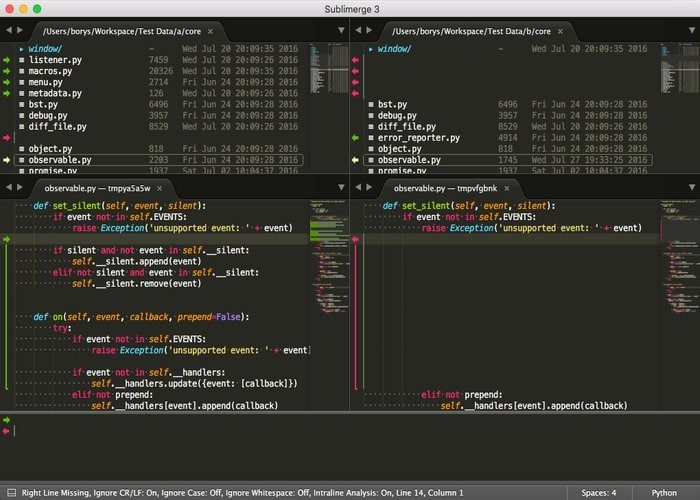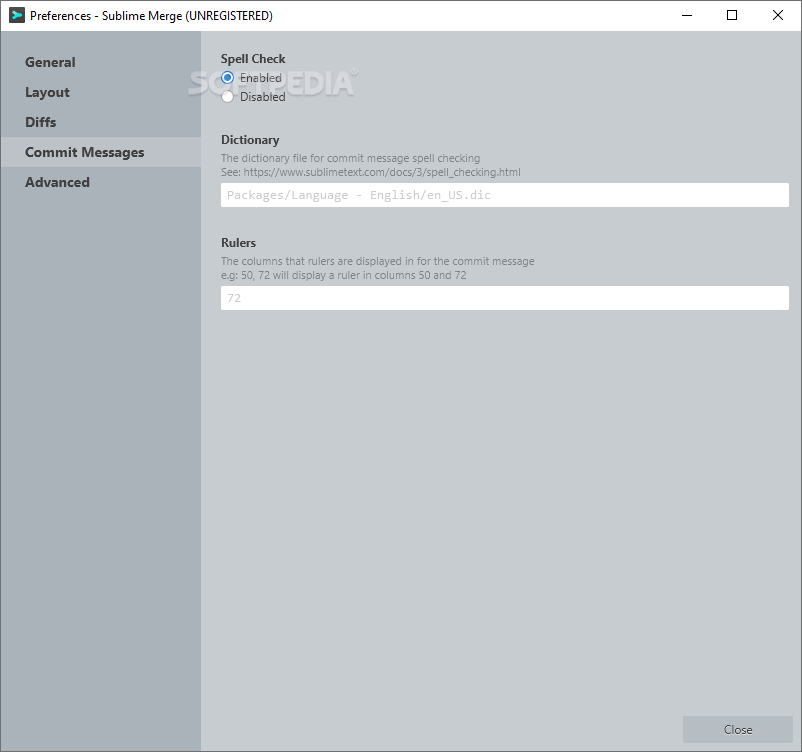
- Sublime merge conflicts how to#
- Sublime merge conflicts install#
- Sublime merge conflicts update#
- Sublime merge conflicts code#
- Sublime merge conflicts mac#
Some shortcuts for updating the MERGED version include:
Sublime merge conflicts update#
Update the MERGED file to resolve a conflict. CTRL+WX to switch places of the windows.įor advanced navigation, information is available with the command :help window-moving.CTLR+WJ to jump to the MERGED window view.The primary navigation commands between these windows are: This result represents what gets saved to the repository. REMOTE shows how the file looks in the remote branch where the conflicting information is.Ĥ. BASE is how the file looked before any changes.ģ. LOCAL represents the file version from the current branch.Ģ. The output displays a window with four views:ġ. To use the mergetool and see the differences, run: git mergetool Set the option to not prompt before running: git config mergetool.prompt false Set the diff tool to show the common ancestor for both files, which is the version before any edits: git config nflictstyle diff3Ĥ. Change the git config to set the default merge tool: git config merge.tool įor example, if using Vim, run: git config merge.tool vimdiffģ.
Sublime merge conflicts how to#
The further steps show an example of how to set up the vimdiff tool for Vim.Ģ.
Vim diff tools: vimdiff, vimdiff2 or vimdiff3. The output prints out all the supported diff tools for your current setup:ĭifferent tools are available based on the editor of choice. Run the following line in your terminal: git mergetool -tool-help To set up the default diff tool for git mergetool:ġ. However, a much more straightforward approach is to use a difference/merging tool to discover the issues and track the changes. Sublime merge conflicts code#
The added syntax helps search through the code to find the location of the merge conflict. The added symbols indicate the ending of the edits within the conflicting branch.
 > (seven "greater than" characters) followed by the branch where the attempted merge happened. Git automatically adds three indicators alongside the conflicting lines of code: Check the file from the error message and look at the contents where the merge conflict happened: The error message prints the information about where the conflict is present. The merge conflict in Git happens when the command git merge throws an error. Ultimately, the choice of what parts of the code stay and which do not depends on the developer's decision for the current project. To make this job more manageable, use special tools to help review individual conflicts. This option is also the best path to take, especially when working with multiple files and people. The final option is to review each change separately. To update the changes on a file from the remote branch, run: git checkout -theirs Īccept the remote version for all conflicting files with: git merge -strategy-option theirsģ. To accept all changes on a file from the local version, run: git checkout -ours Īlternatively, to accept the local version for all conflicting files, use: git merge -strategy-option oursĢ. There are three ways to resolve a merge conflict in Git:ġ. The error message appears and stops the merging process to avoid overwriting changes. During the merge, indicating an overwrite issue. The conflict error message appears before the merge starts to avoid issues. Before merging, indicating there are local changes not up to date. The general types of merge conflicts depend on when the issue appears. Since the problem happens locally and the rest of the project members are unaware of the issue, resolving the conflict is of high priority and requires an immediate fix. Removal of files while changes happen in another place. Changing the same lines of code in a file. Some examples of merge conflicts include: Note: Check out our handy Git Commands Cheat Sheet, which features commonly used commands such as git merge. However, there are situations where git merge is unable to resolve an issue. When working with version control systems such as Git, most merge conflicts resolve automatically.
> (seven "greater than" characters) followed by the branch where the attempted merge happened. Git automatically adds three indicators alongside the conflicting lines of code: Check the file from the error message and look at the contents where the merge conflict happened: The error message prints the information about where the conflict is present. The merge conflict in Git happens when the command git merge throws an error. Ultimately, the choice of what parts of the code stay and which do not depends on the developer's decision for the current project. To make this job more manageable, use special tools to help review individual conflicts. This option is also the best path to take, especially when working with multiple files and people. The final option is to review each change separately. To update the changes on a file from the remote branch, run: git checkout -theirs Īccept the remote version for all conflicting files with: git merge -strategy-option theirsģ. To accept all changes on a file from the local version, run: git checkout -ours Īlternatively, to accept the local version for all conflicting files, use: git merge -strategy-option oursĢ. There are three ways to resolve a merge conflict in Git:ġ. The error message appears and stops the merging process to avoid overwriting changes. During the merge, indicating an overwrite issue. The conflict error message appears before the merge starts to avoid issues. Before merging, indicating there are local changes not up to date. The general types of merge conflicts depend on when the issue appears. Since the problem happens locally and the rest of the project members are unaware of the issue, resolving the conflict is of high priority and requires an immediate fix. Removal of files while changes happen in another place. Changing the same lines of code in a file. Some examples of merge conflicts include: Note: Check out our handy Git Commands Cheat Sheet, which features commonly used commands such as git merge. However, there are situations where git merge is unable to resolve an issue. When working with version control systems such as Git, most merge conflicts resolve automatically. Sublime merge conflicts install#
Vim editor for the tutorial (To install Vim, follow one of our guides: How to Install Vim 8.2 on Ubuntu 18.04 or How to Install Vim 8.2 on CentOS 7). A git merge conflict between a local and remote branch. 
Sublime merge conflicts mac#
Git installed and configured (On Windows, Mac and Ubuntu). The article also provides helpful tips for preventing Git merge conflicts. This guide explains what a merge conflict is and offers resolutions for when they do not sort out automatically. The primary goal of git merge is to resolve or warn about these conflicts automatically. When multiple contributors work on the same part of a code or work with numerous branches, merge conflicts are bound to happen. 
The concept is one of the core ideas of collaborative programming, allowing multiple people to work on their part of the code without any conflicts. The git merge command helps a contributor add to a project from a branch.







 0 kommentar(er)
0 kommentar(er)
